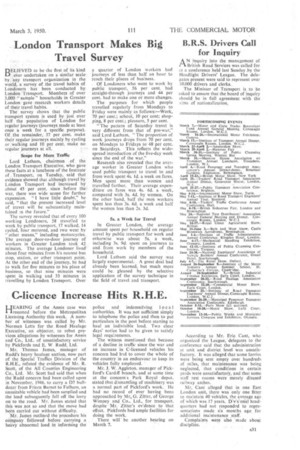London Transport Makes Big
Page 33

If you've noticed an error in this article please click here to report it so we can fix it.
Travel Survey
BLIEVED to be the first of its kind eVer undertaken on a similar scale. by:any transport organization in the world, a survey of the travel habits of Londoners has been conducted by London Transport. Members of over 3,000 " saritple" households in Greater. London gave research workers details of their travel habits.
• The survey shows that the public transport system is used by just over half the population of London for regular journeys (journeys made at least• once a week for a specific purpose). Of the remainder, 37 per cent, make their regular journeys mainly by cycling or walking and 10 per cent. make no regular journeys at all.
Scope for More Traffic Lord Latham, chairman of the London Transport Executive, who gave these facts at a luncheon of the Institute of Transport, on Tuesday, said that evidence showed that although travel by London Transport had increased by abbut 45 per cent. since before the' war, there was wide scope for further expansion. "1 have little doubt." he said, "that the present increased level of travel will be substantially maintained in the future."
The survey revealed that of every I00 working Londoners, 58 travelled to work by public transport, 17 walked, 14 cycled, four motored, and two went by "other means," including motorcycles. The average door-to-door journey of workers in Greater London took 42 minutes. The average Londoner lived about four minutes from his nearest bus stop, station, or other transport point. At the other end of the journey, he had to walk for five minutes to his place of business, so that nine minutes were spent in walking and 33 minutes in travelling by London Transport. Over a quarter of London workers had journeys of less than half an hour to reach their places of business.
Of Londoners who went to work by public transport, 56 per cent, had straight-through journeys and 44 per cent, had to make one or more changes.
The purposes for which people travelled regularly from Mondays to Friday were mainly as follows:-Work, 70 per cent.; school, 10 per cent; shopping, 8 per cent.; pleasure, 5 per cent.
"The pattern of Saturday travel is very different from that of pre-war," said Lord Latham.. "The proportion of work journeys drops from 70 per cent. on Mondays to Fridays to 48 per cent. on Saturdays. This reflects the widespread introduction of the five-day week since the end of the war."
Research also revealed that the average worker in Greater London who used public transport to travel to and from work spent 4s. id. a week on fares. Men spent more than women and travelled farther. Their average expenditure on fares was 4s. 6d. a week, compared with 3s. 4d. by women. On the other hand, half the men workers spent less than 3s, 6d. a week and half the women less than 2s. 3d.
5s. a Week for Travel In Greater London, the average amount spent per household on regular travel by public transport for work and otherwise was about 5s. a week, including 3s. 9d. spent on journeys to and from work by members of the household.
Lord Latham said the survey was largely experimental. A great deal had already been learned, but much more could be. gleaned by the selective application of the survey technique in the field of travel and transport.
































































































